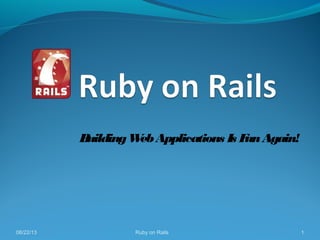Presentationrubyonrails 1221891563546619-8
- 1. 1Ruby on Rails08/22/13 BuildingWebApplications Is FunAgain!
- 2. A collection of good libraries, less works but achieve better results and faster. There are lots of nice tools, classes and methods to make development easier. 2Ruby on Rails08/22/13
- 3. Ruby is: • A High Level Programming Language • Originated in Japan and Rapidly Gaining Mindshare in US and Europe. 3Ruby on Rails08/22/13
- 4. Why Ruby ? • Easy to learn • Open source • Very easy to extend • Truly Object-Oriented • Less Coding with fewer bugs 4Ruby on Rails08/22/13
- 5. Rails is • A web-application framework written in Ruby by David Heinemeier Hansson. • Model-View-Controller 5Ruby on Rails08/22/13
- 6. Model (ActiveRecord ) : Maintains the relationship between Object and Database and handles validation, association, transactions, and more. 6Ruby on Rails08/22/13
- 7. View ( ActionView ) A presentation of data in a particular format, triggered by a controller's decision to present the data. 7Ruby on Rails08/22/13
- 8. Controller ( ActionController ): is the logical center of your application. It coordinates the interaction between the user, the views, and the model. 8Ruby on Rails08/22/13
- 9. A Pictorial Diagram of Ruby on Rails Framework: 9Ruby on Rails08/22/13
- 10. This can be created by using sample helper command C:InstantRailsrails_apps>rails demo Then you will find a directory structure as follow: 10Ruby on Rails08/22/13
- 12. 12Ruby on Rails08/22/13 Go to http://rubyforge.org/projects/instantrails/ 1. Instant Rails 2.0 2. Instant Rails 1.7 3. Instant Rails 1.5 4. Instant Rails 1.4 5. Instant Rails 1.3a
- 13. 13Ruby on Rails08/22/13 1. Unzip Instant Rails on any hard drive 2. Start server Apache and MySQL
- 15. 15Ruby on Rails08/22/13 Go to command prompt by using helper command as follow: C:InstantRails>use_ruby
- 16. 16Ruby on Rails08/22/13 Rails will try to use Mongrel and lighttpd if they are installed, otherwise Rails will use WEBBrick, the webserver that ships with ruby.
- 17. 17Ruby on Rails08/22/13 Windows users are encouraged to Start with Mongrel because it is a Ruby-based webserver that is suitable for development and deployment of Rails applications.
- 18. 18Ruby on Rails08/22/13 • Mysql • Oracle • Postgre Sql • SqlLite • And more…


















